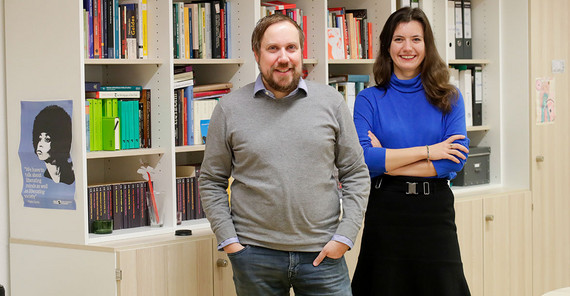“Formats for citizen participation are currently very much in vogue,” says Fabian Schuppert, Professor of Political Theory at the University of Potsdam. They are supposed to fulfill three tasks at once. “By involving mostly representative groups, political action is democratically legitimized to some extent. A tempting idea in light of the now widespread idea that democracy is facing a crisis.” The participation of citizens is also intended to ensure the broad acceptance of political measures even if they do not originate from these formats at all but are perhaps only presented and at best discussed there. Last but not least, those who did participate could come up with suggestions that would ultimately make for better and more efficient climate policies. But how likely is it that these formats will actually be able to do all that – and preferably all at the same time? “There have been few studies on this so far,” Prof. Schuppert says.
Together with the administrative scientist Prof. Dr. Sabine Kuhlmann, Schuppert has launched a research project that analyzes how metropolitan regions develop and implement climate policy. Prof. Kuhlmann examines administrative governance. “We need to investigate how policies are actually produced and executed, which actors shape the respective processes, and what kind of institutional structures can facilitate or impede policy making,” she says.
Participation – but how?
Prof. Schuppert, in turn, researches participatory governance. “Participatory governance aims to create legitimacy and acceptance of the political measures taken, whether in moral, social, or procedural terms,” he says. According to him, this is particularly important for metropolitan regions because in these areas, climate policy is undeniably likely to entail certain losses. “The mobility transition, necessary savings in energy consumption, and even ordinances on structural changes, these are interventions for which you need understanding,” Schuppert explains. “And that doesn’t happen automatically.” Surveys show, for example, that while 97% of people think that something needs to be done about climate change, their willingness to shoulder the costs is low.
This means that policies with the aim to provide solutions to climate change must not only be effective, but also enjoy legitimacy and social acceptance. “It turns out that this is why more and more cities are using participation formats when it comes to implementing and communicating their climate policies,” Schuppert says.
However, it does not always become clear what goals they are pursuing and whether they are actually achieving them. Together with his colleague Janina Walkenhorst, he examined three cities and their participatory approaches to climate policy. With Buenos Aires, Paris, and Berlin, they selected three metropolises that definitely have to deal with similar problems but that take different approaches. “We examined how the participation formats work and what influence they have on decision-making processes,” Walkenhorst says. To do this, the two spoke primarily with actors who are responsible for climate protection strategies or citizen participation in the administration. With the help of qualitative interviews, they wanted to find out what intentions they had when launching the participation formats in the first place. Who was invited to participate? Specific groups or a representative cross-section of the population? What was the goal: to inform about urban climate policy or to collect new ideas for it? What did administrations want to do with the results? And last but not least: How did they communicate all this to the citizens of their city?
The Berlin Model
In Berlin, for example, the Berlin Energy and Climate Protection Program (BEK 2030) was developed from 2015 onwards and adopted by the Berlin House of Representatives in 2018. It defines the strategy that Berlin intends to use in order to achieve its climate targets. It was mainly developed by a project consortium on the basis of scientific expertise. In addition to expert forums, workshops, and public events, there were also two phases of online participation for citizens. They were able to express their wishes and submit proposals on a platform. A commission of experts was tasked with examining these suggestions and including them in the program “if they were suitable.” It is true that the BEK 2030 is to be “updated taking into account new climate targets, scientific findings, and recommendations for action,” as the Senate Administration writes. Essentially, however, the political strategy for the coming years was thus fixed. Nevertheless, a Berlin Climate Citizens’ Council was created in 2021 – “a kind of miniature Berlin, selected by lots from the city’s population.” The council is to develop recommendations that “will be incorporated into the future climate policy of the Senate and the House of Representatives.” But does that work?
Prof. Schuppert’s conclusion is quite mixed: “There are many participatory processes going on in Berlin – unfortunately, not always in a coordinated way. It remains unclear how the results are incorporated into political decisions, which derogates perceived democratic legitimacy.” The goal of the project was therefore to identify best practices in comparison with other metropolises “in order to find solutions for Berlin that work now,” as the researchers say. They have only partially succeeded in doing so, Schuppert sums up. “The results so far do not provide a best-practice toolbox, as we perhaps had in mind. That’s why we also decided to include Amsterdam and Budapest in the study.” Instead, the two were able to show how different the approaches and goals of participatory governance are in the cities.
Berlin, as a city on a small scale, tried to “involve” everyone with its online platform and citizens’ council. In Paris, the participation strategy also aimed at reaching the entire city, Schuppert explains. Buenos Aires, on the other hand, focused on certain groups that are particularly affected by climate change and climate policy: the elderly and socially disadvantaged, for example, but also economic stakeholders. “But it turned out that they didn’t succeed at all in reaching everyone. The people in the slums, for example, were left out,” Walkenhorst says. The Amsterdam administration was concerned – quite successfully – with particularly getting young people involved. “The motto was: Young people will live longer here and should therefore be able to get more involved.”
Looking for best practices
Even the choice of formats usually reveals the purpose for which the cities use participatory instruments. The workshops in Buenos Aires, for example, had the declared aim of providing information about the city’s policies. Participants were thus not meant to actively influence them at all. “Many administrations are primarily concerned with creating awareness of and acceptance for necessary climate protection measures,” Walkenhorst explains. “And they want to see to what extent the population is willing to go along with them.”
It is more difficult to determine how cities deal with the results of workshops, discussions, and surveys aimed at helping to actually shape climate policy. In Paris, for example, citizens were asked to take part in writing the climate strategy. Nevertheless, this is not without problems, as Janina Walkenhorst points out. “The climate crisis requires us to act: Ultimately, climate policy must be efficient and help us achieve our goals, otherwise the best citizen participation is of no use. And that means its foundation must be expert knowledge.” The role of citizens in this case is to discuss how suitable specific measures are for everyday life, how to embed them into the environment, and where specific challenges exist. “In addition, they can contribute their perspective as those affected when it comes to important distribution issues and burdens.” Nevertheless, there is still a strong focus on developing technical climate solutions. But since these originate elsewhere, many proposals from the population tend to be general, unspecific, and non-binding. Like in Berlin. “Everyone could quickly agree on demanding a socially fair climate policy,” she says. However, what that means and how it might be implemented is unclear. “If this is not defined in more detail, it will remain empty and without consequences. At the same time, successful climate adaptation can only happen if justice does not fall by the wayside,” Prof. Schuppert adds. If climate policy based on scientific expertise is ultimately without alternative, a different way of communicating it may be appropriate. “Our research shows that participation formats are not the only way to create social acceptance for policies. There are many different ways to co-create together with citizens.”
In any case, the actual balance sheet for all the cities that have been studied is sobering as far as the direct influence of the involved citizens is concerned. “When examining the climate strategies of cities, we find limited evidence of significant input impact from participation,” Prof. Schuppert says. “If anything, we found it in Paris, but even there it is more of a nice narrative than actually guiding actions.”
Communicating goals is essential
It is particularly problematic that it often remains unclear what goals the cities are pursuing with their participation formats. “Those who fail to communicate clearly what they want to do with the results and how they will be included in the political process lose much more than they think,” Walkenhorst says. That is when participatory governance completely backfires and fails to fulfill any of the three expectations placed in it. No democratic legitimacy, no acceptance of climate policy, no real participation. The best success was perhaps achieved in Amsterdam. “There, it was explained from the beginning that once a certain quota of participation was reached, its results would be included in the political discussion. This expectation management is extremely important.”
According to Prof. Schuppert, it is also noticeable that the administrations of the cities with millions of inhabitants usually fail to take along those on their political course on whom they actually depend: the surrounding regions. “Berlin does not coordinate enough with Brandenburg or the municipalities in the surrounding area,” Walkenhorst says. “The most ambitious goals regarding mobility or the energy transition cannot be achieved, however, if there is no coordination on local public transport or the joint expansion of renewable energies.” In this respect, Berlin showed even worse results than the other cities that were surveyed. In Paris, for example, there are indeed offices that coordinate overarching tasks and connect various stakeholders. “Where there is a little more will to improve coordination, there are also better interlinked policy tools,” Schuppert says.
This knowledge should be the basis for selecting suitable participation formats, he says. After all, it is not a matter of launching as many participatory elements as possible. It is much more important to select the right ones. “Only then will it be possible to develop climate policy in accordance with the population groups that are important and responsible for its implementation.” It’s thus clear: Those who want to make a difference should talk to each other and communicate what they expect from each other.
The Project
Climate Policy Governance from a City-Comparative Perspective: Identifying legitimate and successful climate policy processes for metropolitan areas
Participants: Prof. Dr. Sabine Kuhlmann, Prof. Dr. Fabian Schuppert, Janina Walkenhorst, Franziska Oehlert, Tomas Vellani
Funding: Climate Change Center Berlin Brandenburg and the President of the University of Potsdam
Duration: until the end of 2024 with the possibility of follow-up funding
The Researchers
Prof. Sabine Kuhlmann studied social sciences. Since 2013, she has been Professor of Political Science, Public Administration and Organization in Potsdam.
Email: sabine.kuhlmannuuni-potsdampde
Prof. Dr. Fabian Schuppert studied politics, philosophy, and history at the University of Göttingen and European culture in Glasgow. After working in Helsinki, Belfast, and Zurich he became Professor of Political Theory at the University of Potsdam in 2020.
Email: Sabine.Eichleruuni-potsdampde (secretariat)
Janina Walkenhorst, M.A. studied political science and history at Dresden University of Technology and the University of Potsdam. Since March 2020, she has been an academic assistant at the Chair of Political Theory.
Email: janina.walkenhorstuuni-potsdampde
This text was published in the university magazine Portal Wissen - Eins 2023 „Lernen“ (PDF).


